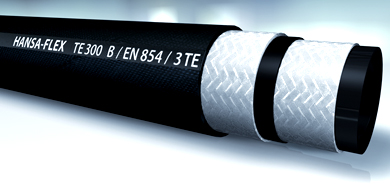TE 300 B (3TE)
Low pressure hose with textile insert Product image
Product image

 Properties
Properties
| Application |
Low pressure hose for general applications. |
| Special features |
Fire tested to DIN 54 837 with DIN 5510 Part 2 classification (test reports on request) |
| Standard |
EN 854 3 TE |
| Inner layer |
synthetic rubber NBR |
| Insert |
two textile braided inserts |
| Outer layer |
flame retardant, oil resistant, weatherproof synthetic rubber |
| Colour |
black |
| Temp. min. |
-40 °C |
| Temp. max. |
100 °C |
| Media |
Mineral oil base light heating oil Lubricating oil Water Air (up to + 70°C) Water-glycol emulsions |
 Item
Item

Sort upwards
Sort downwards
 Identification Identification |
DN* | Size | Inches | Internal Ø (mm) |
External Ø (mm) |
Operating pressure (bar) |
Test pressure (bar) |
Burst pressure (bar) |
Min. bending radius (mm) |
Colour |
|---|---|---|---|---|---|---|---|---|---|---|
| TE 306 B | 6 | 4 | 1/4" | 6,4 | 14,4 | 145,0 | 290 | 580 | 45 | black |
| TE 308 B | 8 | 5 | 5/16" | 7,9 | 16,9 | 130,0 | 260 | 260 | 55 | black |
| TE 310 B | 10 | 6 | 3/8" | 9,5 | 18,5 | 110,0 | 220 | 440 | 70 | black |
| TE 313 B | 12 | 8 | 1/2" | 12,7 | 21,7 | 93,0 | 189 | 370 | 85 | black |
| TE 316 B | 16 | 10 | 5/8" | 15,6 | 25,9 | 80,0 | 160 | 320 | 105 | black |
| TE 320 B | 19 | 12 | 3/4" | 19,0 | 29,0 | 70,0 | 140 | 280 | 130 | black |
| TE 325 B | 25 | 16 | 1" | 25,4 | 35,9 | 55,0 | 110 | 220 | 150 | black |
| TE 332 B | 31 | 20 | 1.1/4" | 31,8 | 42,3 | 45,0 | 90 | 180 | 190 | black |
DN = Nominal diameter, nominal width
Disclaimer
Despite careful checking, we cannot guarantee the accuracy of all information included on this site, and we accept no liability.
All data and information in our online catalogue are based on currently valid standards and the regulations from the employer's liability insurance association. Product safety can only be guaranteed when our assembly instructions are carefully observed. Non-adherence to these regulations can affect product operation and functioning and result in a loss of warranty. Our warranty is only valid for HANSA-FLEX products. Our products are constantly subject to further development and technical changes are therefore possible.



 Select language
Select language
 Bulgarian (Български)
Bulgarian (Български)
 Chinese (汉语)
Chinese (汉语)
 Croatian (Hrvatski)
Croatian (Hrvatski)
 Czech (Čeština)
Czech (Čeština)
 Dutch (Nederlands)
Dutch (Nederlands)
 Estonian (Eesti)
Estonian (Eesti)
 French (Français)
French (Français)
 German (Deutsch)
German (Deutsch)
 Hungarian (Magyar)
Hungarian (Magyar)
 Italian (Italiano)
Italian (Italiano)
 Latvian (Latviešu)
Latvian (Latviešu)
 Lithuanian (Lietuvių k.)
Lithuanian (Lietuvių k.)
 Polish (Polski)
Polish (Polski)
 Portuguese (Português)
Portuguese (Português)
 Romanian (Română)
Romanian (Română)
 Russian (Русский)
Russian (Русский)
 Serbian (Српска)
Serbian (Српска)
 Slovakian (Slovenčina)
Slovakian (Slovenčina)
 Slovenian (Slovenščina)
Slovenian (Slovenščina)
 Spanish (Español)
Spanish (Español)
 Turkish (Türkçe)
Turkish (Türkçe)

